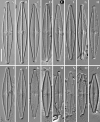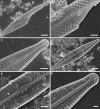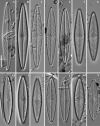Two new species of Navicula (Bacillariophyta) from Southeast Asia
- PMID: 35437382
- PMCID: PMC8881437
- DOI: 10.3897/phytokeys.190.78164
Two new species of Navicula (Bacillariophyta) from Southeast Asia
Abstract
We present light and scanning electron microscopical observations on two new species of Navicula Bory sensu stricto from Southeast Asia. Naviculawinoniformis Chudaev, Glushchenko, Kulikovskiy & Kociolek, sp. nov. differs from taxa with similar outline and size by the combination of simple drop-like external raphe endings deflected to the primary valve side, presence of well-developed external longitudinal grooves and relatively low lineolae density. Naviculasparsilineolata Chudaev, Glushchenko, Kulikovskiy & Kociolek, sp. nov. can be discriminated from the taxa of similar valve shape and size by consistently lower lineolae density, and from the majority of them also by the structure of external proximal raphe endings with small projections in proximal parts and larger triangular insertions in distal parts. Some remarks on Navicula species diversity and its distribution in the Southeast Asia are given.
Keywords: Diatoms; Navicula; Southeast Asia; distribution; freshwaters; morphology; new species; taxonomy.
Maxim S. Kulikovskiy, Dmitry A. Chudaev, Anton M. Glushchenko, Irina V. Kuznetsova, John Patrick Kociolek.
Figures




References
-
- Bahls LL. (2012) Seven new species in Navicula sensu stricto from the Northern Great Plains and Northern Rocky Mountains. Nova Hedwigia 141: 19–38.
-
- Carter JR, Bailey-Watts AE. (1981) A taxonomic study of diatoms from standing freshwaters in Shetland. Nova Hedwigia 33(3/4): 513–630.
-
- Chudaev DA, Gololobova MA. (2016) Diatoms of Lake Glubokoe (Moscow Region). Moscow, KMK, 447 pp. [in Russian]
-
- Chudaev DA, Glushchenko AM, Blagoveshchenskaya EY, Karthick B, Kulikovskiy MS. (2018) Morphology and taxonomy of Naviculaescambia and N.simulata (Bacillariophyceae). Nova Hedwigia. Beiheft 147: 43–57. 10.1127/nova-suppl/2018/006 - DOI
-
- Chudaev DA, Jüttner I, Glushchenko AM, Kulikovskiy MS, Gurung S, Williams DM. (2020) On the geographical distribution of Naviculanielsfogedii J.C. Taylor & Cocquyt. Diatom Research 35(2): 185–192. 10.1080/0269249X.2020.1758794 - DOI
LinkOut - more resources
Full Text Sources
